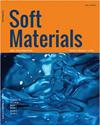Preparation and characterization of chitosan/polyethylene glycol and cobalt ferrite magnetic-polymeric nanoparticles as resveratrol carriers: preparation, analytical methodology validation and in vitro applicability
IF 1.4
4区 材料科学
Q4 MATERIALS SCIENCE, MULTIDISCIPLINARY
引用次数: 1
Abstract
ABSTRACT The objective of this research was to produce, characterize and evaluate biological activities of magnetic-polymeric nanoparticles loaded with resveratrol. Magnetic nanoparticles of cobalt ferrite (CoFe2O4), polymeric nanoparticles of chitosan (CS) and polyethylene glycol (PEG), and polymeric-magnetic nanoparticles containing resveratrol (RSV) were developed. An analytical method using UV-VIS spectroscopy was developed and validated for the determination of RSV in the nanoparticles. The samples were analyzed by dynamic light scattering (DLS) for size, polydispersity index (PDI) and zeta potential. The encapsulation efficiency was determined by an indirect method. Antioxidants (ABTS and DPPH) and antibacterial (MIC and CBM) activities were evaluated. The average size of the nanoparticles varied between 184.6 and 276.5 nm. The magnetic-polymeric nanoparticles showed high encapsulation efficiency (EE) (98.75%) with a slow and prolonged release rate of 33.49% in 120 h. Furthermore, three months of storage showed less than 10% of RSV degradation. Its antioxidant activity (AA) was 170.55 mmol TE g−1 (by the ABTS method) and 130.60 mmol TE g−1 (by the DPPH method). The resveratrol-loaded magnetic-polymeric nanoparticles inhibited the growth of four tested bacteria. Their MIC values were less than 52.36 µg mL−1, and the CBM values of the nanoparticles >52.36 µg mL−1. HIGHLIGHTS Cobalt ferrite NPs coated with chitosan and polyethylene glycol were synthesized for the targeted delivery of resveratrol. CoFe2O4 NPs coated with CS/PEG loaded with RSV showed average size of 234.40 nm. Resveratrol was encapsulated (>95%) onto CoFe2O4 NPs coated with chitosan/PEG. RSV-loaded nanoparticles were effective as a scavenger of ABTS and DPPH radicals, suggesting applications in processes involving oxidative stress. RSV-loaded magnetic-polymeric NPs showed antibacterial activity against four Gram-negative and Gram-positive bacteria.壳聚糖/聚乙二醇和钴铁氧体磁性聚合物纳米粒子作为白藜芦醇载体的制备和表征:制备、分析方法验证和体外适用性
摘要:本研究的目的是制备、表征和评价负载白藜芦醇的磁性聚合物纳米颗粒的生物活性。制备了钴铁氧体磁性纳米粒子(CoFe2O4)、壳聚糖(CS)和聚乙二醇(PEG)的聚合纳米粒子以及含白藜芦醇(RSV)的聚合磁性纳米粒子。建立并验证了紫外可见光谱法测定纳米颗粒中RSV的分析方法。采用动态光散射(DLS)对样品的尺寸、多分散性指数(PDI)和zeta电位进行了分析。采用间接法测定包封效率。测定抗氧化活性(ABTS和DPPH)和抗菌活性(MIC和CBM)。纳米颗粒的平均尺寸在184.6 ~ 276.5 nm之间。磁性高分子纳米颗粒的包封效率(EE)高达98.75%,120 h缓释率为33.49%,3个月对RSV的降解率低于10%。其抗氧化活性(AA)分别为170.55 mmol TE g−1 (ABTS法)和130.60 mmol TE g−1 (DPPH法)。负载白藜芦醇的磁性聚合物纳米颗粒抑制了四种被测细菌的生长。纳米颗粒的MIC值均小于52.36µg mL−1,CBM值均小于52.36µg mL−1。制备了壳聚糖和聚乙二醇包被的钴铁氧体NPs,用于白藜芦醇的靶向递送。CS/PEG包覆的CoFe2O4 NPs平均粒径为234.40 nm。将白藜芦醇包被(>95%)在壳聚糖/聚乙二醇包被的CoFe2O4 NPs上。负载rsv的纳米颗粒作为ABTS和DPPH自由基的有效清除剂,提示在氧化应激过程中的应用。负载rsv的磁性聚合物NPs对4种革兰氏阴性菌和革兰氏阳性菌均有抗菌活性。
本文章由计算机程序翻译,如有差异,请以英文原文为准。
求助全文
约1分钟内获得全文
求助全文
来源期刊

Soft Materials
工程技术-材料科学:综合
CiteScore
2.90
自引率
0.00%
发文量
21
审稿时长
2.2 months
期刊介绍:
Providing a common forum for all soft matter scientists, Soft Materials covers theory, simulation, and experimental research in this rapidly expanding and interdisciplinary field. As soft materials are often at the heart of modern technologies, soft matter science has implications and applications in many areas ranging from biology to engineering.
Unlike many journals which focus primarily on individual classes of materials or particular applications, Soft Materials draw on all physical, chemical, materials science, and biological aspects of soft matter. Featured topics include polymers, biomacromolecules, colloids, membranes, Langmuir-Blodgett films, liquid crystals, granular matter, soft interfaces, complex fluids, surfactants, gels, nanomaterials, self-organization, supramolecular science, molecular recognition, soft glasses, amphiphiles, foams, and active matter.
Truly international in scope, Soft Materials contains original research, invited reviews, in-depth technical tutorials, and book reviews.
 求助内容:
求助内容: 应助结果提醒方式:
应助结果提醒方式:


